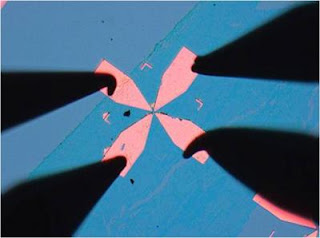Researchers at Rensselaer Polytechnic Institute use water to open, tune graphene's band gap.
Troy, N.Y. – Researchers at Rensselaer Polytechnic Institute developed a new method for using water to tune the band gap of the nanomaterial graphene, opening the door to new graphene-based transistors and nanoelectronics.
By exposing a graphene film to humidity, Rensselaer Professor Nikhil Koratkar and his research team were able to create a band gap in graphene – a critical prerequisite to creating graphene transistors. At the heart of modern electronics, transistors are devices that can be switched "on" or "off" to alter an electrical signal. Computer microprocessors are comprised of millions of transistors made from the semiconducting material silicon, for which the industry is actively seeking a successor.
Graphene, an atom-thick sheet of carbon atoms arranged like a nanoscale chain-link fence, has no band gap. Koratkar's team demonstrated how to open a band gap in graphene based on the amount of water they adsorbed to one side of the material, precisely tuning the band gap to any value from 0 to 0.2 electron volts.
In its natural state, graphene has a peculiar structure but no band gap. It behaves as a metal and is known as a good conductor. This is compared to rubber or most plastics, which are insulators and do not conduct electricity. Insulators have a large band gap – an energy gap between the valence and conduction bands – which prevents electrons from conducting freely in the material.
Between the two are semiconductors, which can function as both a conductor and an insulator. Semiconductors have a narrow band gap, and application of an electric field can provoke electrons to jump across the gap. The ability to quickly switch between the two states – "on" and "off" – is why semiconductors are so valuable in microelectronics.
"At the heart of any semiconductor device is a material with a band gap," Koratkar said. "If you look at the chips and microprocessors in today's cell phones, mobile devices, and computers, each contains a multitude of transistors made from semiconductors with band gaps. Graphene is a zero band gap material, which limits its utility. So it is critical to develop methods to induce a band gap in graphene to make it a relevant semiconducting material."
The symmetry of graphene's lattice structure has been identified as a reason for the material's lack of band gap. Koratkar explored the idea of breaking this symmetry by binding molecules to only one side of the graphene. To do this, he fabricated graphene on a surface of silicon and silicon dioxide, and then exposed the graphene to an environmental chamber with controlled humidity. In the chamber, water molecules adsorbed to the exposed side of the graphene, but not on the side facing the silicon dioxide. With the symmetry broken, the band gap of graphene did, indeed, open up, Koratkar said. Also contributing to the effect is the moisture interacting with defects in the silicon dioxide substrate.
"Others have shown how to create a band gap in graphene by adsorbing different gasses to its surface, but this is the first time it has been done with water," he said. "The advantage of water adsorption, compared to gasses, is that it is inexpensive, nontoxic, and much easier to control in a chip application. For example, with advances in micro-packaging technologies it is relatively straightforward to construct a small enclosure around certain parts or the entirety of a computer chip in which it would be quite easy to control the level of humidity."
Based on the humidity level in the enclosure, chip makers could reversibly tune the band gap of graphene to any value from 0 to 0.2 electron volts, Korarkar said. ###
Along with Koratkar, authors on the paper are Theodorian Borca-Tasciuc, associate professor in the Department of Mechanical, Aerospace, and Nuclear Engineering at Rensselaer; Rensselaer mechanical engineering graduate student Fazel Yavari, who was first author on the paper; Rensselaer Focus Center New York Postdoctoral Research Associate Churamani Gaire; and undergraduate student Christo Kritzinger. Co-authors from Rice University are Professor Pulickel M. Ajayan; Postdoctoral Research Fellow Li Song; and graduate student Hemtej Gulapalli.
This study was supported by the Advanced Energy Consortium (AEC), National Institute of Standards and Technology (NIST) Nanoelectronics Research Initiative, and the U.S. Department of Energy Office of Basic Energy Sciences (BES).
Contact: Michael Mullaney mullam@rpi.edu 518-276-6161 Rensselaer Polytechnic Institute















No comments:
Post a Comment